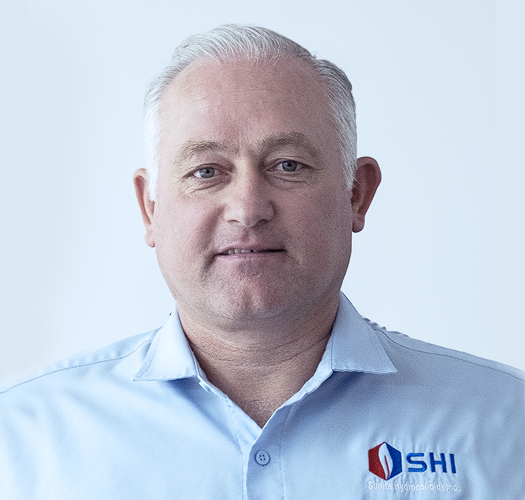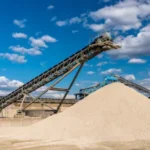What Are Surfactants and Why Are They Critical in Oil & Gas Fracturing?

Hydraulic fracturing drives US oil and gas output but the chemistry behind it often gets overlooked. Surfactants are key additives that control viscosity, reduce surface tension and improve fluid recovery. These chemical additives owe their effectiveness to their amphiphilic nature which allows them to interact with both water and oil phases. They help unlock hydrocarbons from tight formations and boost well productivity.
This blog breaks down what surfactants are, how they work, why they matter and how Sunita Hydrocolloids Inc. The USA supports oilfield operations with advanced surfactant solutions.
What are Surfactants?
Surfactants (short for surface active agents) are organic compounds designed to modify fluid behavior. Each molecule features a hydrophilic head group that bonds with water and a hydrophobic tail (often referred to as an alkyl chain) that repels it. The presence of these functional groups allows surfactants to self-assemble into molecular clusters (micelles) in a solution.
The length of the alkyl chain and head group determines the behavior and classification of surfactants. This dual structure allows surfactants to reduce surface and interfacial tension between fluids and rock surfaces. In hydraulic fracturing, this helps with fluid recovery, viscosity control and mobilization of trapped hydrocarbons from tight formations.
Surfactants also support proppant transport and reduce friction during high pressure injection. Their chemistry is central to oilfield stimulation and advanced surfactant types are engineered for performance across varied reservoir conditions.
How Do Surfactants Work in Hydraulic Fracturing?
Surfactants are more than just chemical additives; they’re performance drivers in hydraulic fracturing. Surfactants are typically used in aqueous solutions during hydraulic fracturing where their surface activity at the oil water interface and air water interface is critical for reducing interfacial tension. Their molecular behavior directly impacts how efficiently oil and gas are released from tight formations.
The effectiveness of surfactants depends on surfactant concentration with different effects observed at low concentration and high concentrations. In aqueous surfactant solutions, surfactant molecules interact with water molecules and oil phases to facilitate the mobilization of hydrocarbons.
Surfactants work by:
A. Reducing Surface and Interfacial Tension
Surfactants lower the interfacial tension between water based fracturing fluids and hydrocarbons, specifically at the oil water interface. This reduces oil and gas molecules from the rock surface and allows them to move more freely towards the wellbore. Lower interfacial tension means higher mobility which translates to higher hydrocarbon recovery rates from low permeability reservoirs.
B. Enhancing Flowback Efficiency
After fracturing, a large portion of the injected fluid is trapped due to capillary forces. Surfactants, which can also function as wetting agents, help reduce capillary forces and improve fluid return during flowback. This not only improves cleanup but also reduces fluid retention that can block hydrocarbon pathways. Better flowback means less formation damage and more efficient well stimulation.
C. Wettability Alteration
Certain surfactants can shift reservoir rock wettability from oil wet to water wet. This allows water based fluids to displace oil from the pore surfaces. Wettability alteration is especially useful in tight shale where oil tends to stick to the rock surfaces. The result is more oil displacement and higher production.
D. Improving Emulsification and Dispersion
During fracturing, emulsions can form between oil, water and solids. These emulsions can clog pore spaces and reduce flow. Surfactants help break these emulsions and disperse particles evenly throughout the fluid, preventing blockages, minimizing formation damage and maintaining consistent flow through the reservoir. Effective dispersion also supports better proppant transport and fluid recovery.
Why Surfactants Are Critical in Oil & Gas Fracturing
Surfactants are chemical additives that enable high efficiency in hydraulic fracturing operations. Their role directly impacts recovery rates, operational flexibility, cost efficiency and environmental compliance. They help in:
1. Boosting Production Rates
Surfactants improve oil and gas mobility by reducing interfacial tension between fluids and rock surfaces. This effect can increase recovery rates significantly in some formations. Surfactant based fracturing fluids enhance flowback and hydrocarbon release especially in low permeability reservoirs. This makes surfactants a key driver in maximizing output from tight formations.
2. Compatibility with Diverse Reservoirs
Surfactants can be formulated to suit different reservoir types – shale, sandstone or carbonate. This adaptability allows operators to match surfactant chemistry with formation characteristics, improving stimulation outcomes. Whether the goal is wettability alteration or drag reduction, surfactants offer field ready flexibility that supports consistent performance across varied geologies.
3. Cost Effective Performance Enhancer
Surfactants deliver measurable ROI without requiring infrastructure upgrades. By improving fluid recovery and reducing formation damage, they help operators get more from each well. For example, surfactant polymer blends have shown success in boosting flowback rates while minimizing friction losses. This translates into lower operational costs and better resource utilization.
4. Environmental Considerations
Modern surfactants are engineered for low toxicity and biodegradability. Biosurfactants, in particular, meet rising ESG standards while outperforming synthetic alternatives. These can reduce surface tension at lower concentrations and maintain production gains over time while aligning with environmental regulations and sustainability goals
Types of Surfactants Used in Fracturing
Surfactants used in hydraulic fracturing are selected based on reservoir temperature, salinity, rock type and fluid design. Each type offers unique benefits in oil and gas stimulation.
- Anionic Surfactants – They carry a negative charge and excel at emulsifying oil and water. These are commonly used in sandstone formations for their strong interfacial tension reduction.
- Cationic Surfactants – These are positively charged and ideal for altering wettability in carbonate reservoirs. They help shift rock surfaces from oil wet to water wet, improving hydrocarbon flow.
- Nonionic Surfactants – These have neutral charge, effective in low temperature and high salinity environments. Their stability makes them suitable for diverse fluid systems.
- Amphoteric Surfactants – Their charge varies with pH, offering adaptability across reservoir conditions. These are useful in complex formations with fluctuating chemistry.
Leading oilfield suppliers such as Sunita Hydrocolloids Inc. offer proprietary blends that combine surfactant types for optimized performance. These blends are engineered to boost flowback, reduce formation damage and meet ESG standards.
Surfactants and Unconventional Reservoirs
Unconventional reservoirs like shale and tight formations present unique challenges: narrow pore throats, low permeability, high surface tension and complex mineralogy. These conditions restrict fluid flow and trap hydrocarbons making recovery difficult. Surfactants help overcome these barriers by reducing interfacial tension and altering wettability which improves fluid mobility and minimizes water blockage.
They significantly enhance flowback and hydrocarbon release in low permeability zones. Their role is especially critical in unconventional plays where traditional fracturing fluids fall short. Surfactant selection needs to match reservoir chemistry to unlock trapped oil and gas efficiently.
Real World Applications: Industry Adoption
Big oilfield service companies have been incorporating surfactant technology into their stimulation programs across major US basins including the Permian, Eagle Ford and Bakken. These surfactants increase fluid recovery, extend well life and support customized stimulation for complex formations.
Biosurfactants in shale completions outperform traditional chemistries, boosting initial production and flowback over time. It’s a move towards performance driven and ESG compliant solutions that deliver significant ROI and meet operational and regulatory requirements.
Why Choose Surfactants from Sunita Hydrocolloids Inc. USA
Sunita Hydrocolloids Inc. USA offers high performance surfactants as part of its well completion chemical solutions. These surfactants are engineered to enhance hydrocarbon recovery, improve flowback efficiency and reduce surface tension across diverse fracturing fluids. Designed for compatibility with US field conditions, they support stimulation programs in shale, tight sands and carbonate plays. Each formulation is performance optimized to meet operational and ESG goals.
Conclusion
Surfactants are essential to modern hydraulic fracturing. They drive recovery, protect formations and support ESG goals. Choosing the right surfactant is a strategic move that impacts well economics and long term output. Sunita Hydrocolloids Inc. USA offers field proven surfactant solutions engineered for US oilfield performance.
Explore our surfactant technologies and contact us for product support and application guidance.





